Comprehensive Guide to Membrane Switches: Types, Structures, and Operating Principles
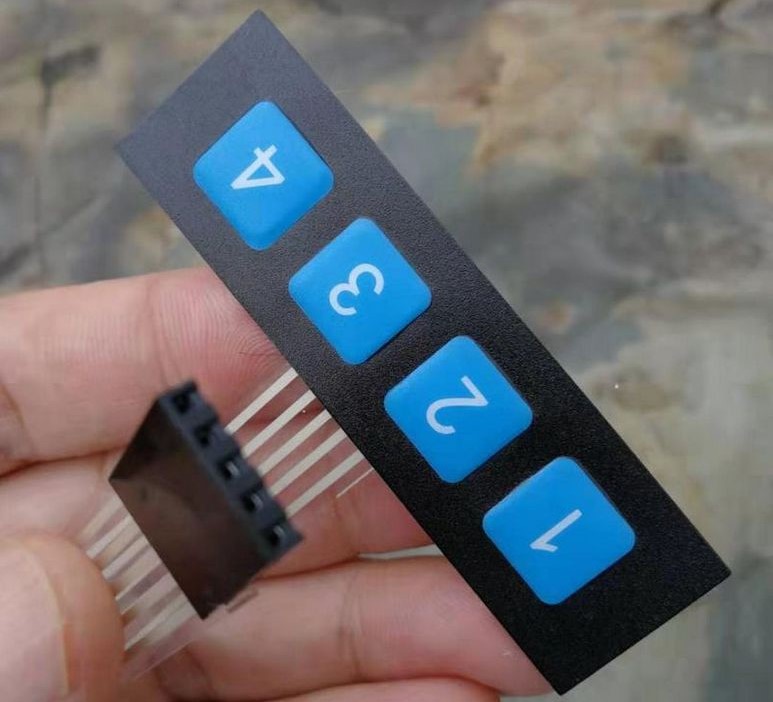
Membrane switch
Also known as touch keyboard, it adopts an integral sealed structure composed of a flat multi-layer combination. It is a new type of electronic component that integrates light, machine and electricity, and seals the key switch, panel, mark, symbol display and lining together. It is a fundamental change in the appearance structure of electronic products. It can replace the keys of conventional discrete components and perform the tasks of the operating system more reliably. Membrane switches have good waterproof, dustproof, oil-proof, and anti-corrosion of harmful gases. The performance is stable and reliable, light weight, small size, long life, easy assembly, the panel can be washed without damage to the characters, rich colors, and beautiful appearance. Using membrane switches makes your products more contemporary. Main types of membrane switches The membrane switch panel is an electronic component that integrates switch functions and decorative functions, consisting of a rigid or flexible printed circuit board as the base, with buttons with or without feel installed, and then covered with a plastic (polycarbonate PC, polyester PET, etc.) film panel printed with colorful decorative patterns. It is a new type of human-computer dialogue interface. The connection between its switch circuit and the whole machine can be completed by welding or plugging.
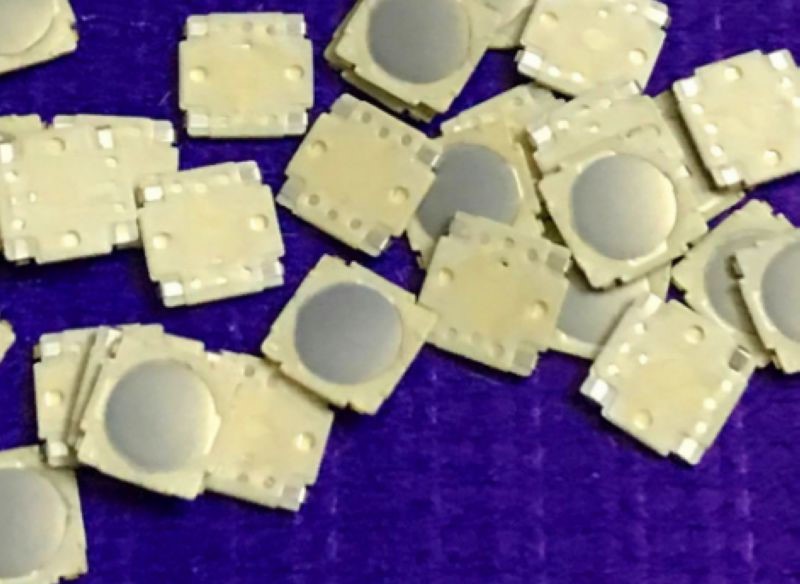
Types of membrane switches
1. Flexible membrane switch
Flexible membrane switch is a typical form of membrane switch. This type of membrane switch is called flexible because the mask layer, isolation layer, and circuit layer of the membrane switch are all composed of flexible films of various properties. The circuit layer of the flexible membrane switch uses polyester film (PET) with good electrical properties as the carrier of the switch circuit pattern. This layer is also divided into hand-feel springs and upper and lower circuits. Due to the properties of polyester film, the membrane switch has good insulation, heat resistance, folding resistance and high resilience. The graphics of the switch circuit, including the switch connection and its lead wires, are printed with low-resistance, low-temperature cured conductive paint. Therefore, the composition of the entire membrane switch has a certain degree of softness, which is not only suitable for use on flat bodies, but also can be used with curved bodies. The lead wires of the flexible membrane switch are integrated with the switch body. When making the connection of the group switch, they are gathered at a certain place on the membrane and extended outward according to the position specified in the design and the standard line spacing. They are connected to the rear circuit of the whole machine as soft, arbitrarily bendable and sealed lead wires.

2. Rigid membrane switch
Rigid membrane switch refers to a switch whose graphics and circuits are made on a common printed circuit copper-clad board. The characteristics of rigid membrane switch are convenient material acquisition, stable process, low resistance, and certain components in the circuit can be directly welded on its back. In the case of a small area, the rigid lining layer can be omitted. Rigid membrane switches generally use metal guides as the contact points for conducting the labyrinth, so they have a better feel. The disadvantage is that they are not as convenient to install in the whole machine as soft membrane switches, and often require welding and lead-out through flat cables. In addition to buzzer signals and LED indications, the information feedback of rigid membrane switches generally uses metal feel springs.
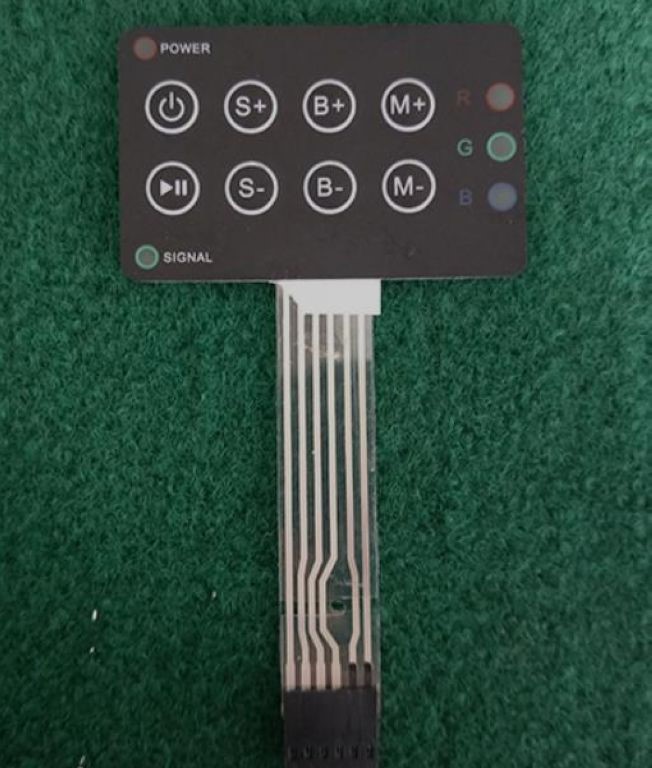
3. Flat membrane switch
The buttons on the membrane switch use different colors to indicate the position, shape and size of the key body, which is more common in the initial stage of membrane switches. Three-dimensional membrane switch: Usually, the buttons on the membrane switch only use colors to express the position, shape and size of the key body. In this way, the accuracy of the operation can only be identified by the operator's vision. Since there is no appropriate feedback information to indicate whether the finger is pressed within the effective range of the switch to make the switch operate, it affects the confidence in monitoring the entire machine and the speed of operation. A membrane switch that makes the switch key body slightly raised and slightly higher than the panel to form a three-dimensional shape is called a three-dimensional key switch. The three-dimensional key can not only accurately give the range of the key body, improve the recognition speed, and make the operator's sense of touch more sensitive, but also enhance the decorative effect of the product appearance. The production of three-dimensional keys.
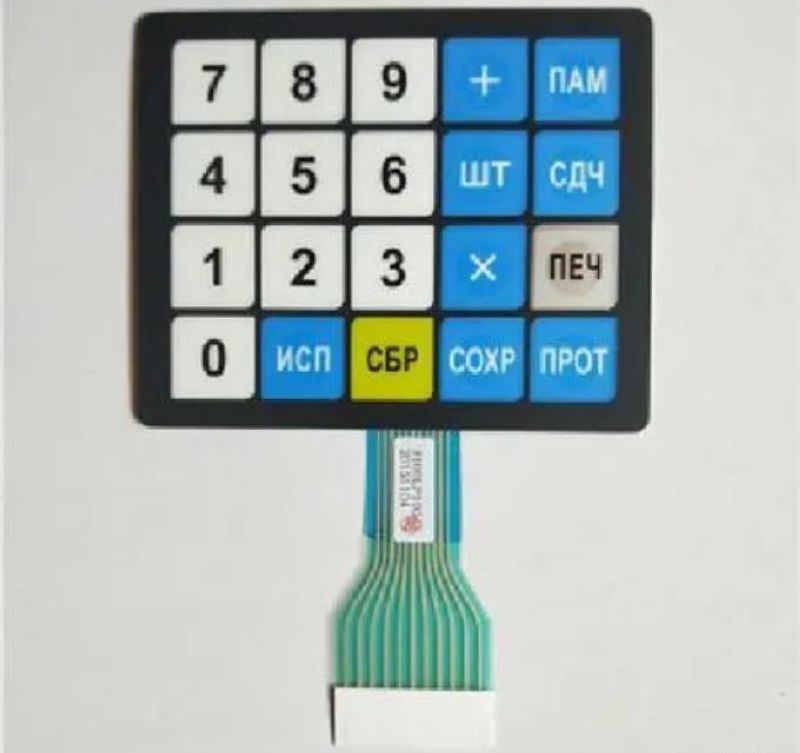
4. Raised membrane switch
Usually, the buttons on the membrane switch only use colors to express the position, shape and size of the key body. In this way, the accuracy of the operation can only be identified by the operator's vision. Since there is no appropriate feedback information, it affects the confidence in monitoring the machine and the speed of operation. Therefore, arrangements must be made in the design stage of the panel, and process holes must be prepared to ensure accurate positioning during mold pressing. The height of the three-dimensional protrusion should generally not exceed twice the thickness of the substrate. In order to beautify the appearance of the product, the protrusion of the raised membrane switch can be made in a variety of variations.
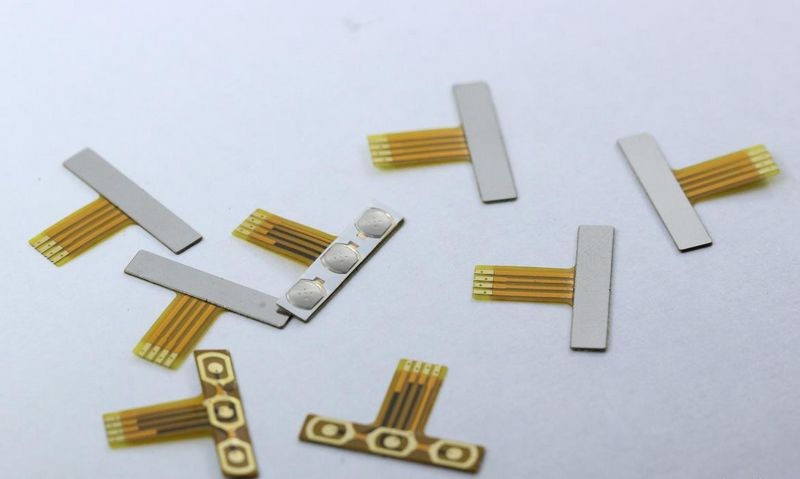
Basic structure of membrane switch
Generally speaking, common membrane switches are mainly composed of 6 layers of materials, which are panel, surface adhesive, upper circuit and lower circuit, isolation interlayer, and bottom adhesive in order from the outside to the inside.
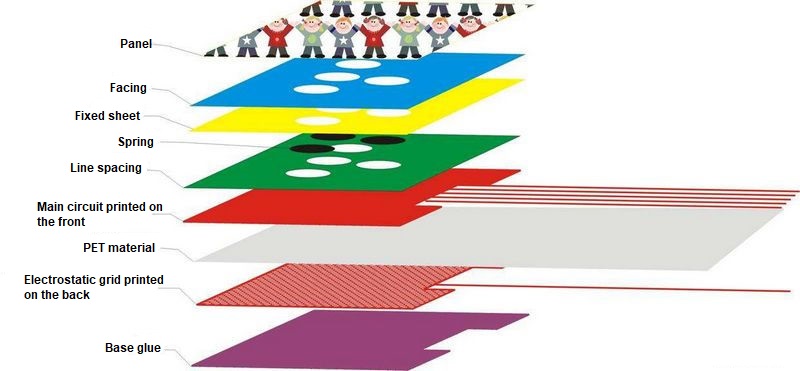
The following is an introduction to the structure of each layer:
1. Panel layer
The panel layer is generally made by silk-screening exquisite patterns and texts on colorless and translucent sheets such as PET and PC with a thickness less than 0.25MM. Since the main function of the panel layer is to serve as a logo and button, the selected material must have the characteristics of high transparency, high ink adhesion, high elasticity, and high toughness.
2. Surface adhesive layer
The main function of the surface adhesive is to connect the panel layer and the circuit layer tightly to achieve the effect of sealing and connection. This layer is generally required to be between 0.05-0.15MM thick and have high adhesion and anti-aging properties. In production, special membrane switch double-sided adhesive is generally selected. Some membrane switches require waterproof and high temperature resistance, so the surface adhesive must also use materials of different properties according to needs.
3. Control circuit upper and lower layers
This layer uses high-performance polyester film (PET) as the carrier of the switch circuit pattern and uses a special process to screen-print conductive silver paste and conductive carbon paste on it to make it conductive. Its thickness is generally within 0.05-0.175MM, and the most common is 0.125MM PET.
4. Interlayer
It is located between the upper circuit and the lower circuit layer and plays a role in sealing and connecting. Generally, PET double-sided adhesive is used, and its thickness varies from 0.05 to 0.2MM. When selecting the material of this layer, the overall thickness, insulation, circuit key package feel and sealing of the product should be fully considered.
5. Back adhesive layer
The use of back adhesive is closely related to the material to which the membrane switch is attached. Common double-sided adhesive, 3M adhesive, waterproof adhesive, etc. are commonly used.
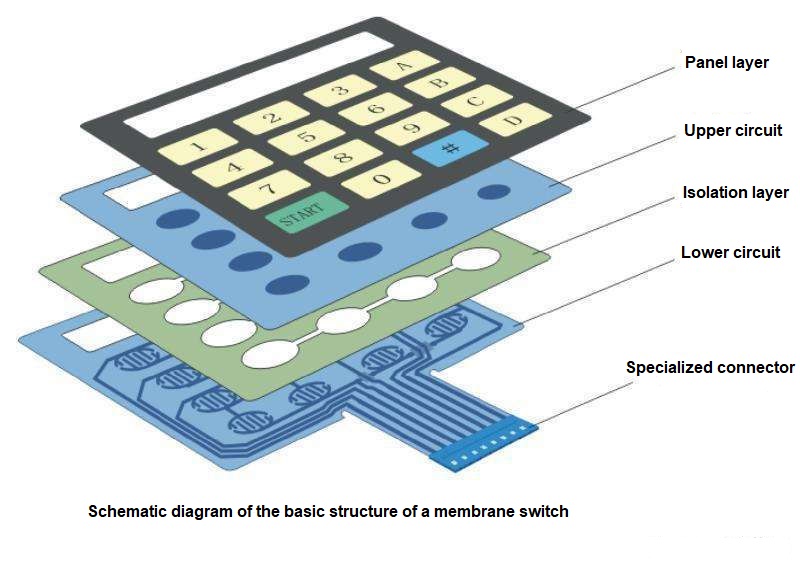
Working principle of membrane switch
When the panel is not pressed, the membrane switch is in normal state, its upper and lower contacts are disconnected, and the isolation layer isolates the upper and lower circuits; when the panel is pressed, the contacts of the upper circuit deform downward, overlap with the lower circuit and make the circuit conductive, and the conductive circuit sends a signal to the external connection instrument (substrate), thereby realizing its corresponding function; when the finger is released, the contacts of the upper circuit rebound, the circuit is disconnected, and the loop triggers a signal.
Technical parameters of membrane switch
1. Electrical performance
(1) Working voltage: ≤50V (DC)
(2) Working current: ≤100mA
(3) Contact resistance: 0.5~10Ω
(4) Insulation resistance: ≥100MΩ (100V/DC)
(5) Substrate withstand voltage: 2kV (DC)
(6) Rebound time: ≤6ms
(7) Loop resistance: 50Ω, 150Ω, 350Ω, or determined by user needs.
(8) Insulation ink withstand voltage: 100V/DC
2. Mechanical properties
(1) Reliability and service life: >1 million times
(2) Closing displacement: 0.1~0.4mm (non-tactile type) 0.4~1.0mm (tactile type)
(3) Standard force: 15~750g
(4) Conductive silver paste migration: at 55℃, temperature 90%, after 56 hours, the line is 10MΩ/50VDC
(5) No oxidation and impurities on the silver paste line
(6) Silver paste line width ≥0.3mm, minimum spacing 0.3mm, line burrs <1/3, line gap <1/4 line width
(7) Pin spacing standard 2.54 2.50 1.27 1.25 1.0 0.5mm
(8) Lead wire anti-bending, use d=10mm steel rod to roll 80 times without breaking the line
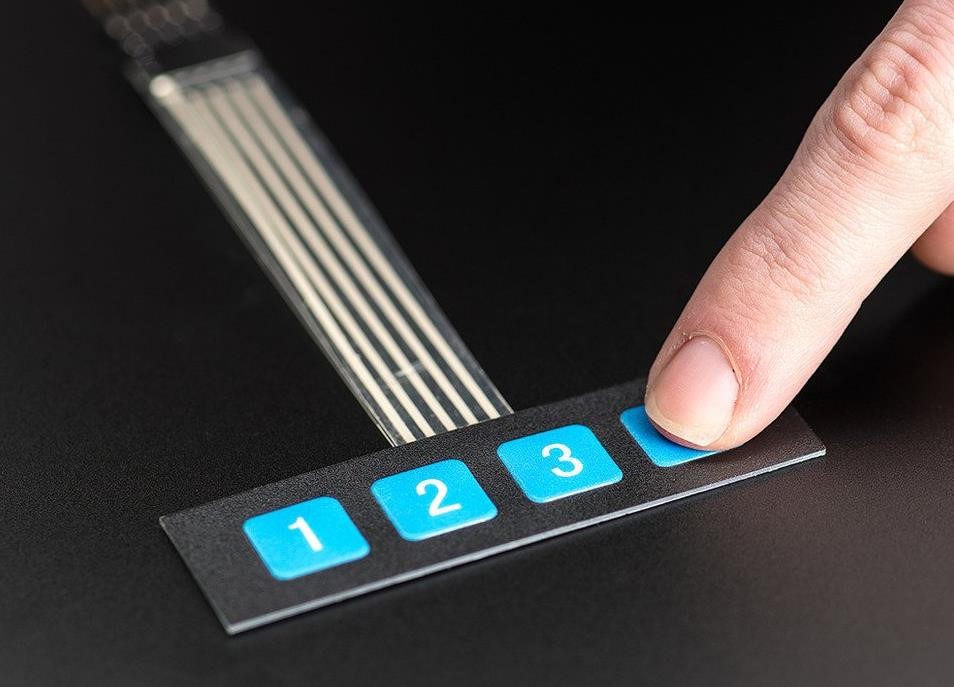
3. Environmental performance
(1) Working temperature: -20℃~+70℃
(2) Storage temperature: -40℃~+85℃ Temperature 95%±5%
(3) Atmospheric pressure: 86~106KPa
4. Printing indicators
(1) Printing size deviation ±0.10mm, unclear outer edge line deviation ±0.1mm
(2) Color registration deviation ±0.11mm/100mm, insulating ink fully covers the silver paste circuit
(3) No ink scattering, no missing characters
(4) Color difference is no more than two levels
(5) No creases or paint peeling
(6) The transparent window is transparent and clean, with uniform color, and no scratches, pinholes, or impurities.
5. Precautions for using membrane switches
(1) The bubble film between membrane switches is to reduce the pressure on the keys and prevent failure, so it should be retained;
(2) The transparent film on the front and back of the membrane switch is to protect the display window of the membrane switch. Do not tear it off easily;
(3) After taking out a few membrane switches, they should be tied as they were, but they must not be tied too tightly;
(4) Membrane stickers and membrane switches that have a good feel and are in large quantities need to be packed and placed vertically to prevent the keys from failing due to long-term heavy pressure;
(5) The output wires of the membrane switch should be protected and should not be placed facing downwards;
(6) For membrane switches with display windows, the material should be prevented from bending under force when being picked up and placed, which will leave creases;
(7) Membrane switches should be stored in a room at normal temperature and should be dust-proof and moisture-proof. There should be no acidic, alkaline or other corrosive gases in the surrounding air.
